The Albert Hall
Tamar Street, Launceston
B. 1860 Charles Brindley, Sheffield;
opened 24/6/1861 in the People's Hall of Mechanics Institute, Launceston.
Reb. & inst. present loc. 1891 Fincham & Hobday with new case.
Res. 1980 K.R. Davis; tonal finishing Geo. Fincham & Sons.
3m., 29 sp.st., 4c., tr.
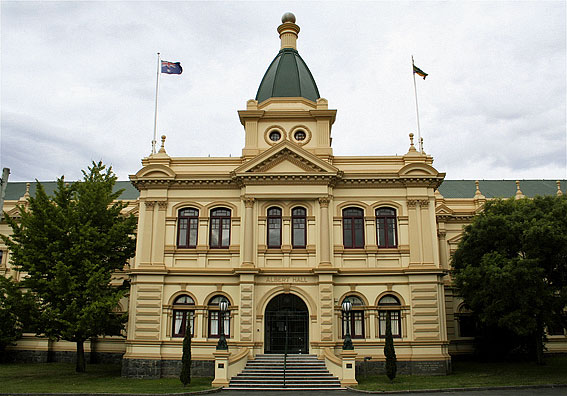
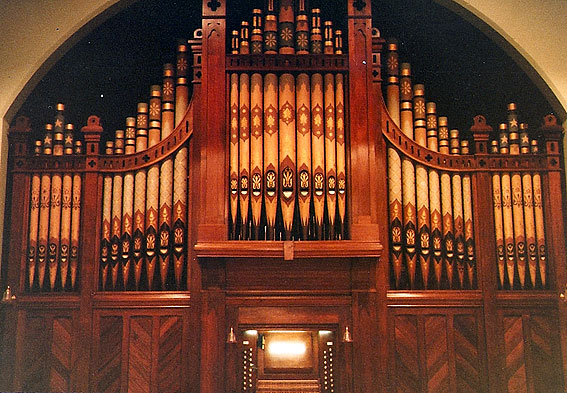
From the 2002 OHTA Conference handbook:
The Albert Hall, built in 1889-91 for the Tasmanian International Exhibition of 1891-92, was designed by local architect John Duncan in a High Victorian classical idiom [1]. The main hall, of vast proportions, includes a surrounding gallery with cast iron balustrading, and a substantial stage, at the rear of which is placed the organ chamber.
Charles Brindley, of Sheffield, built this instrument under the direction of Dr E.J. Hopkins, organist of the Temple Church, London [2] and co-author, with E.F. Rimbault, of The Organ: its History and Construction. It was possibly Hopkins who was responsible for the enlightened English ‘classical’ tonal design [3]. The organ was shipped on the Alfred Hawley and erected in the People’s Hall of the Mechanics Institute by Mr [Jesse] Biggs, of Hobart, who had also erected the Brindley organ in St David’s Cathedral, Hobart [4]. Biggs (1819-1872) was an English organbuilder who emigrated from Bromham, Bedfordshire in the mid-1850s; he is known to have been working in Melbourne from 1856 and later settled in Tasmania [5].
The organ was opened at the unusual time of 2.00 p.m. on Monday 24 June 1861 by Mr Pringle of Melbourne. Pringle was born in London in 1833, the son of a professor of music, and arrived in Melbourne in June 1857 [6]. He was organist at St Andrew’s Brighton before being appointed to the same post at St Peter’s Eastern Hill, Melbourne in mid-September 1859. Frustrated in his efforts to improve the old organ at St Peter’s, he left at the end of April 1868 to take up “the more lucrative post of organist and director of music at the Cathedral Church of St Francis” [7]. He was also conductor of the Royal Melbourne Philharmonic Society in 1865-66, and its organist in 1858-59 and 1870 [8]. During his stay in Melbourne he gave opening recitals on numerous organs and took part in the opening programme at the Melbourne Town Hall on 9 August 1870 [9]. He left for Europe with his wife and four young children, and died of brain fever early in 1873 in Leipzig, where “he had been residing . . . for the express purpose of following up the study of his adopted instrument, the organ” [10].
The Examiner (Launceston) for 20 June 1862, p.5. reported:
OPENING OF THE ORGAN AT THE MECHANICS’ INSTITUTE
|
This was the first secular organ of any substance anywhere in Australia and with the sister Brindley organ at St Andrew’s Presbyterian Church, Hobart, probably the largest in Australia at the time. It is of great interest in showing the strong influence on English organbuilding by the German organbuilder Edmund Schulze, with whom Brindley had worked before establishing his firm in 1854 [11]. The Schulze influence is particularly evident in the extensive use of metal Gedacts, the choruses of Spitzflötes and Gemshorns, the splendidly composed quint mixtures, and the use of chromatic slider chests and ‘simplified’ actions.
In 1890 the organ was placed in the new pavilion in City Park, which Hobart organist, F.A. Packer, thought was “a magnificent one for sound; in fact he never heard one better, not even the Melbourne Town Hall” [12].
In 1891 the organ was moved from the pavilion to the newly-erected Albert Hall, where it was installed by Fincham & Hobday, of Melbourne. The firm comprehensively restored the instrument at a cost of £370 and provided a new case in Tasmanian blackwood, incorporating 33 non-speaking pipes, all elaborately stencilled [13]. The original Brindley case, like that at St John’s Church, consisted of dummy pipes; regrettably no photographs of it installed at the Mechanics Institute survive. The hydraulic engine, made by Thomas Melvin & Sons, St. Rollox Iron Works, Glasgow Patent, with index dial at the console, was installed at this time and is connected to a set of vertical generator bellows. The original tonal scheme appears not to have been modified by Fincham & Hobday [14], although a scheme for minor alterations exists in the firm’s records [15].
Following a period of sad neglect, when the instrument became unplayable, it was completely restored by Keith Davis, Launceston, this work being completed in 1980. The actions and soundboards were restored, a new electric blower fitted to supplement the restored hydraulic engine, and the pipework repaired and fitted with tuning slides. The final regulation of the pipework was carried out by George Fincham & Sons, Melbourne, with Knud Smenge responsible for the tonal finishing [16]
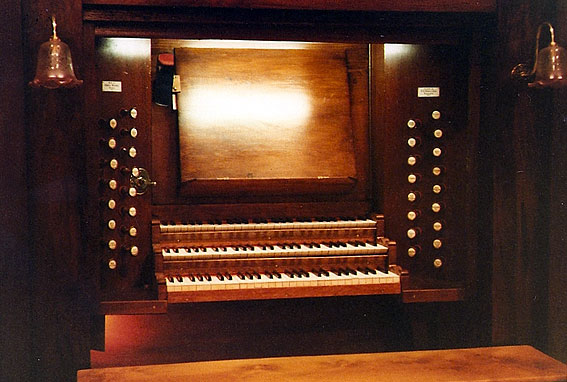
| GREAT Double Stopt Diapason Open Diapason Gamba Rohr Flöte Principal Flute Twelfth Fifteenth Mixture Trumpet SWELL Double Diapason Gemshorn Flaut d’Amour Gemshorn Mixture Horn Oboe Clarion CHOIR Spitz Flöte Lieblich Gedact Dulciana Spitz Flöte Lieblich Flöte Piccolo Clarinette PEDAL Major Bass Bourdon Flute Bass Trombone |
16 8 8 8 4 4 2-2/3 2 V 8 16 8 8 4 IV 8 8 4 (8 (8 (8 4 4 2 8 16 16 8 16 |
gvd bass 15.19.22.26.29 gvd bass 15.19.22.26 common bass " " " " " " TC wood |
4 couplers
6 composition pedals
trigger swell lever
mechanical action
compass: 56/30 [17]
| Great Mixture V | Swell Mixture IV | |||
| C - f f# - c¹ c#¹- c² c#²- g³ |
15.19.22.26.29 12.15.19.22.26 8.12.15.19.22 1. 8.12.15.19 |
C - B c - c² c#²- f² f#²- g³ |
15.19.22.26 12.15.19.22 8.12.15.19 1. 8.12.15 |
|
|
[18] |
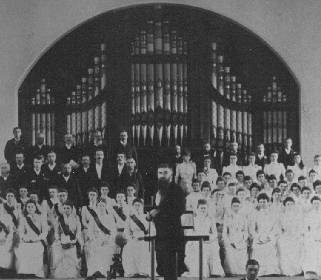

Water engine
[1] The Heritage of Tasmania: the Illustrated Register of the National Estate (South Melbourne: Macmillan, 1983), p.122; Launceston: a Pictorial History (Launceston: Queen Victoria Museum & Art Gallery, 1989), p.65; The Albert Hall 1890-1980.
[2] Examiner 20 April 1861, p.5.
[3] cf specification XVI quoted in E.J. Hopkins & E.F. Rimbault The Organ . . . 3rd ed. (London: Cocks, 1877), p.317.
[4] Examiner 20 April 1861, p.5.
[5] ‘Jesse Biggs – organbuilder’, OHTA News, vol. 26, no 2 (April 2002), p.4.
[6] E.N. Matthews, Colonial Organs and Organbuilders (Carlton: Melbourne University Press, 1969), p.74 (notes on Pringle kindly provided by Geoffrey Cox).
[7] Geoffrey Cox, ’The First Organ at St Peter’s Eastern Hill, Melbourne, Part I: The Organ and Early Organists’, OHTA News, vol. 19, no 2 (April 1995), pp. 24-27.
[8] W.A. Carne. A Century of Harmony (Melbourne: Royal Melbourne Philharmonic Society, 1954), pp.39, 61-63, 287
[9] Matthews, op.cit. pp. 74-75, 81, 111-113, 144, 148-49, 151
[10] The Age (11 March 1873), p.2, col 6; see also The Argus (5 July 1873), p.5, col 5 and (22 August 1873), p.7, col 2, and Matthews, op. cit. pp. 74-75
[11] J.R. Knott, ‘Brindley and Foster – organbuilders of Sheffield’, OHTA News, vol. 2, no. 3 (July 1978), p.17
[12] Examiner, 17 December 1890, quoted in Stefan Petrow, Going to the Mechanics: a History of the Launceston Mechanics’ Institute 1842-1914 (Launceston: Historical Survey of Northern Tasmania, 1998), p.104
[13] Fincham letters 14/244, quoted in [John Henwood], ‘Restorations – Albert Hall, Launceston, Tasmania’, OHTA News, vol.1, no. 1 (July 1977), pp. 17-21; E.N. Matthews, op. cit, p.199
[14] John Stiller, Albert Hall, Launceston, Tasmania; Detailed Documentation of Pipe Organ Built by Charles Brindley for the Mechanics’ Institute Launceston Installed 1860: investigated 5-8 and 12 February 1979 (Camberwell: Organ Historical Trust of Australia, 1979), p.3
[15] Fincham letters 6/324, 7/50, quoted in [John Henwood], ‘Restorations – Albert Hall, Launceston, Tasmania’, OHTA News, vol. 1, no. 1 (July 1977), pp.17-21
[16] Notes, John Maidment
[17] Specification noted 1967 John Maidment
[18] Details of mixtures supplied by John Stiller
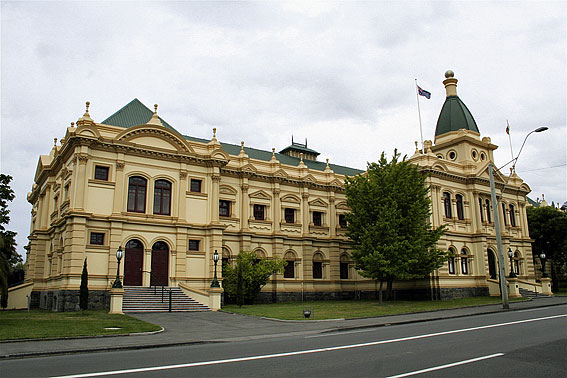
Exterior photos: Trevor Bunning (Dec 2008)
Organ photos: Mark Quarmby (Oct 1983)